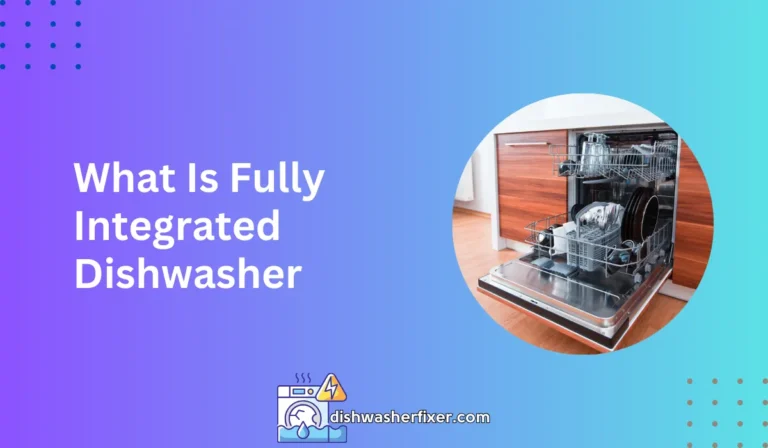How Can I Tell Where My Dishwasher is Leaking From? Detect & Fix!
To identify a dishwasher leak, inspect the door gasket for damage, check hoses and connections underneath for drips, and examine the pump seals for wear. Water marks or pooling indicate the leak source. Use a flashlight for better visibility.
Identifying Common Leak Locations

Door Seal/Gasket
The door seal or gasket of your dishwasher is the first line of defense against leaks. It runs along the perimeter of the door and ensures water stays inside the appliance during a wash cycle.
Over time, the seal can become brittle, crack, or lose its elasticity, leading to leaks. To check for issues, inspect the entire length of the gasket for any signs of damage. Look for cracks, warping, or areas where the gasket has come loose from the door.
Water Inlet Valve
The water inlet valve controls the flow of water into your dishwasher. A malfunctioning valve can cause leaks either by not closing fully or by being stuck open, allowing water to seep through.
Such leaks are usually found at the bottom of the machine. To diagnose issues with the inlet valve, you may need to remove the kickplate or lower panel of the dishwasher to gain access and look for drips or corrosion.
Pump and Pump Seals
The pump circulates water within the dishwasher and can be a common source of leakage. It’s typically located at the bottom of the dishwasher, and any issues with the pump or its seals may result in water leaking onto the floor.
Check for dampness or water marks around the pump housing, and visually inspect the seals for any signs of wear or degradation.
Hoses and Clamps
Hoses and clamps transport water to and from your dishwasher. If these become loose or damaged, they can be the culprit for leaks.
It’s important to inspect all hoses for signs of wear, such as cracks or blisters, and to ensure clamps are tight and secure.
Pay special attention to the areas where hoses connect to the dishwasher and to the plumbing system.
Spray Arm Assemblies
The spray arms are responsible for distributing water during a wash cycle. If they are cracked or have become loose, they can cause water to spray directly onto the door seal, which may not be designed to handle such force.
This can lead to water escaping past the door seal and onto your kitchen floor. Inspecting the spray arms for damage and ensuring they are securely attached can prevent such leaks.
Troubleshooting Steps for Locating the Leak

Visual Inspection When Dishwasher is Off
Before running any tests, visually inspect your dishwasher while it’s turned off. Use a flashlight to examine the areas around the base, underneath the appliance, and around the door.
Look for any noticeable signs of dripping, corrosion, or water damage. Water marks or pooling on the floor can give clues about where the leak might be originating from.
Running a Cycle to Observe Leaks
One effective way to locate a leak is by running a cycle and observing your dishwasher in action. As it fills, washes, and drains, check for any water escaping from the appliance.
Keep an eye on the common leak locations such as the door seal, inlet valve, and hose connections. Remember to exercise caution and be ready to stop the cycle if the leak is severe.
Checking for Loose Connections and Damaged Parts
While your dishwasher is off, check all connections and parts for looseness or damage. Make sure the hoses are securely attached with their clamps, and inspect the water inlet valve and pump for any signs of malfunction.
Tightening loose connections may solve the problem, but damaged parts will likely require replacement.
Dye Testing for Hard-to-Find Leaks
If you’re struggling to find the source of the leak, dye testing can be a helpful method. Add a few drops of food coloring to the water in your dishwasher, then run a cycle.
The colored water will make it easier to spot where the leak is happening, as the dye will leave a traceable path.
Isolating the Dishwasher from Power and Water
For safety reasons, it’s crucial to isolate the dishwasher from power and water before conducting any in-depth inspections or repairs. Turn off the circuit breaker and shut off the water supply to the dishwasher.
This will prevent any accidental electrical shocks or water damage while you work on locating and fixing the leak.
DIY Repair vs. Professional Assistance

Assessing the Severity of the Leak
To decide whether to tackle the repair yourself or call in a professional, assess the severity of the leak.
A small drip from a loose hose might be an easy fix, while a faulty pump may require more expertise. Consider your comfort level with appliance repairs and the complexity of the issue at hand.
When to Replace Parts Yourself
If you have identified the source of the leak and feel confident in your ability to replace parts, doing it yourself can save money.
Simple replacements like a worn gasket or a loose clamp are generally within the realm of a DIY fix. Ensure you purchase the correct parts for your dishwasher model and follow the manufacturer’s instructions carefully.
Safety Precautions for DIY Repairs
When attempting DIY repairs, safety should be your top priority. Always disconnect the dishwasher from power and water before starting.
Use proper tools and protective equipment, such as gloves and eyewear, to avoid injuries. If you’re unsure at any point, it’s best to seek professional assistance.
Benefits of Professional Repair Services
Professional repair services offer expertise and a guarantee of workmanship. A trained technician can accurately diagnose and fix the problem, often with a warranty on the repair.
This can provide peace of mind and save you time and potential frustration, especially for more complex issues.
How to Choose a Reliable Appliance Repair Service
When selecting a professional appliance repair service, look for companies with good reviews and a solid reputation.
Ensure they have experience with your brand of dishwasher and can provide a clear estimate of the costs involved. It’s also important to check that they are licensed and insured to protect yourself in the event of any problems.
FAQs About Dishwasher Leak Detection
How can I check the dishwasher door gasket for leaks?
Inspect the door gasket for any signs of damage such as cracks or brittleness. Close the door and see if there are any gaps or if the seal is not tight.
What should I look for underneath the dishwasher to identify a leak?
Check hoses and connections for any drips or moisture. Use a flashlight to ensure better visibility and inspect for any signs of water marks or corrosion.
How can I tell if the dishwasher pump seals are worn out?
Examine the pump seals for any signs of wear or deterioration. If there is evidence of leaking water or a noticeable leak when the dishwasher is running, it may indicate failing pump seals.
What are the signs of a leaking dishwasher when inspecting the interior?
Look for water marks on the interior surfaces, pooling water at the bottom of the dishwasher, or any irregularities in the water level after a cycle.
Are there any external signs that can indicate my dishwasher is leaking?
Yes, check for water pooling on the floor around the dishwasher or water marks on the cabinets or walls adjacent to the appliance, indicating a possible leak.
Final Thoughts
To pinpoint a dishwasher leak, thoroughly inspect the door gasket, hoses, connections, and pump seals for any signs of damage or wear
Keep an eye out for water marks or pooling around the appliance, which can reveal the origin of the leak. Employ a flashlight to enhance visibility during your investigation.





